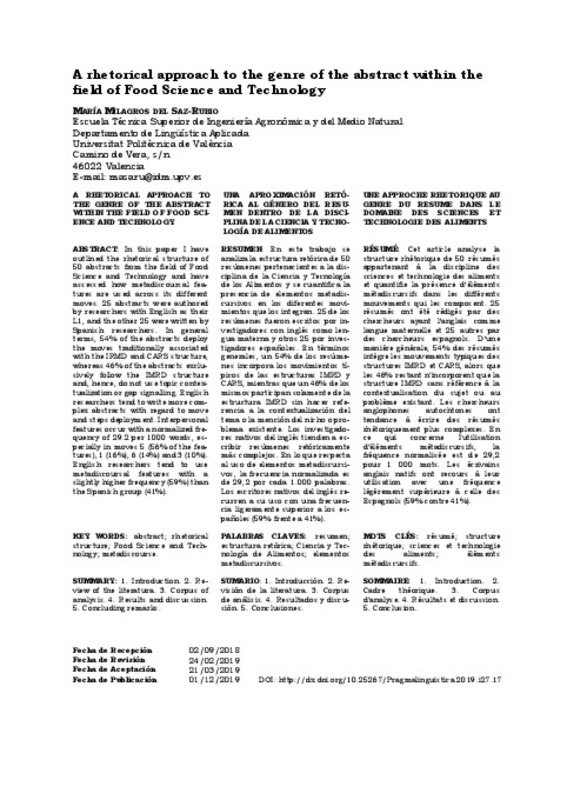JavaScript is disabled for your browser. Some features of this site may not work without it.
Buscar en RiuNet
Listar
Mi cuenta
Estadísticas
Ayuda RiuNet
Admin. UPV
A rhetorical approch to the genre of the abstract within the field of Food Science and Technology
Mostrar el registro sencillo del ítem
Ficheros en el ítem
| dc.contributor.author | Saz Rubio, María Milagros del
|
es_ES |
| dc.date.accessioned | 2021-01-30T04:31:21Z | |
| dc.date.available | 2021-01-30T04:31:21Z | |
| dc.date.issued | 2019-12-01 | es_ES |
| dc.identifier.issn | 1133-682X | es_ES |
| dc.identifier.uri | http://hdl.handle.net/10251/160295 | |
| dc.description.abstract | [EN] In this paper I have outlined the rhetorical structure of 50 abstracts from the field of Food Science and Technology and have assessed how metadiscoursal features are used across its different moves. 25 abstracts were authored by researchers with English as their L1, and the other 25 were written by Spanish researchers. In general terms, 54% of the abstracts deploy the moves traditionally associated with the IRMD and CARS structure, whereas 46% of the abstracts exclusively follow the IMRD structure and, hence, do not use topic contextualization or gap signalling. English researchers tend to write more complex abstracts with regard to move and steps deployment. Interpersonal features occur with a normalized frequency of 29.2 per 1000 words, especially in moves 5 (56% of the features), 1 (16%), 6 (14%) and 3 (10%). English researchers tend to use metadiscoursal features with a slightly higher frequency (59%) than the Spanish group (41%). | es_ES |
| dc.description.abstract | [ES] En este trabajo se analiza la estructura retórica de 50 resúmenes pertenecientes a la disciplina de la Ciencia y Tecnología de los Alimentos y se cuantifica la presencia de elementos metadiscursivos en los diferentes movimientos que los integran. 25 de los resúmenes fueron escritos por investigadores con inglés como lengua materna y otros 25 por investigadores españoles. En términos generales, un 54% de los resúmenes incorpora los movimientos típicos de las estructuras IMRD y CARS, mientras que un 46% de los mismos participan solamente de la estructura IMRD sin hacer referencia a la contextualización del tema o la mención del nicho o problema existente. Los investigadores nativos del inglés tienden a escribir resúmenes retóricamente más complejos. En lo que respecta al uso de elementos metadiscursivos, la frecuencia normalizada es de 29,2 por cada 1.000 palabras. Los escritores nativos del inglés recurren a su uso con una frecuencia ligeramente superior a los españoles (59% frente a 41%). | es_ES |
| dc.language | Inglés | es_ES |
| dc.publisher | Servicio de Publicaciones de la Universidad de Cadiz | es_ES |
| dc.relation.ispartof | Pragmalingüística | es_ES |
| dc.rights | Reconocimiento - No comercial - Sin obra derivada (by-nc-nd) | es_ES |
| dc.subject | Abstract | es_ES |
| dc.subject | Rhetorical structure | es_ES |
| dc.subject | Food Science and Technology | es_ES |
| dc.subject | Metadiscourse | es_ES |
| dc.subject | Resumen | es_ES |
| dc.subject | Estructura retórica | es_ES |
| dc.subject | Ciencia y Tecnología de Alimentos | es_ES |
| dc.subject | Elementos metadiscursivos | es_ES |
| dc.subject.classification | FILOLOGIA INGLESA | es_ES |
| dc.title | A rhetorical approch to the genre of the abstract within the field of Food Science and Technology | es_ES |
| dc.title.alternative | Una aproximación retórica al género del resumen dentro de la disciplina de la ciencia y tecnología de alimentos | es_ES |
| dc.type | Artículo | es_ES |
| dc.identifier.doi | 10.25267/Pragmalinguistica.2019.i27.17 | es_ES |
| dc.rights.accessRights | Abierto | es_ES |
| dc.contributor.affiliation | Universitat Politècnica de València. Departamento de Lingüística Aplicada - Departament de Lingüística Aplicada | es_ES |
| dc.description.bibliographicCitation | Saz Rubio, MMD. (2019). A rhetorical approch to the genre of the abstract within the field of Food Science and Technology. Pragmalingüística. (27):328-348. https://doi.org/10.25267/Pragmalinguistica.2019.i27.17 | es_ES |
| dc.description.accrualMethod | S | es_ES |
| dc.relation.publisherversion | https://doi.org/10.25267/Pragmalinguistica.2019.i27.17 | es_ES |
| dc.description.upvformatpinicio | 328 | es_ES |
| dc.description.upvformatpfin | 348 | es_ES |
| dc.type.version | info:eu-repo/semantics/publishedVersion | es_ES |
| dc.description.issue | 27 | es_ES |
| dc.relation.pasarela | S\400386 | es_ES |








